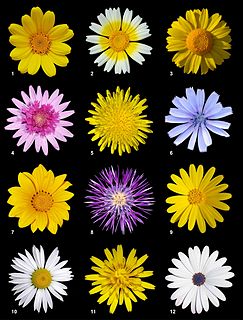
The family Asteraceae, alternatively Compositae, consists of over 32,000 known species of flowering plants in over 1,900 genera within the order Asterales. Commonly referred to as the aster, daisy, composite, or sunflower family, Compositae were first described in the year 1740. The number of species in Asteraceae is rivaled only by the Orchidaceae, and which is the larger family is unclear as the quantity of extant species in each family is unknown.

Senecio is a genus of flowering plants in the daisy family (Asteraceae) that includes ragworts and groundsels.
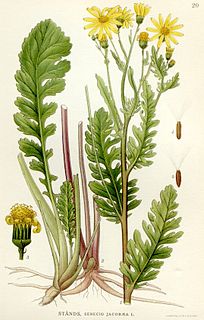
Jacobaea vulgaris, syn. Senecio jacobaea, is a very common wild flower in the family Asteraceae that is native to northern Eurasia, usually in dry, open places, and has also been widely distributed as a weed elsewhere.

Senecio vulgaris, often known by the common names groundsel and old-man-in-the-spring, is a flowering plant in the family Asteraceae. It is an annual herb, native to Europe and widely naturalised as a ruderal species in suitable disturbed habitats worldwide.

Jacobaea maritima, commonly known as silver ragwort, is a perennial plant species in the genus Jacobaea in the family Asteraceae, native to the Mediterranean region. It was formerly placed in the genus Senecio, and is still widely referred to as Senecio cineraria; see the list of synonyms (right) for other names.

A pseudanthium is an inflorescence that resembles a flower. The word is sometimes used for other structures that are neither a true flower nor a true inflorescence. Examples of pseudanthia include flower heads, composite flowers, or capitula, which are special types of inflorescences in which anything from a small cluster to hundreds or sometimes thousands of flowers are grouped together to form a single flower-like structure. Pseudanthia take various forms. The real flowers are generally small and often greatly reduced, but the pseudanthium itself can sometimes be quite large.

Packera aurea, commonly known as golden ragwort or simply ragwort, is a perennial flower in the family Asteraceae. It is also known as golden groundsel, squaw weed, life root, golden Senecio, uncum, uncum root, waw weed, false valerian, cough weed, female regulator, cocash weed, ragweed, staggerwort, and St. James wort.

Tolmiea menziesii is a species of flowering plant in the family Saxifragaceae. It is known by the common names youth on age, pick-a-back-plant, piggyback plant, and thousand mothers. It is a perennial plant native to the West Coast of North America, occurring in northern California, Oregon, Washington, British Columbia and southern Alaska. It occurs as a naturalised plant or garden escapee in Scotland, parts of Wales, Northern Ireland and northern and western parts of England.
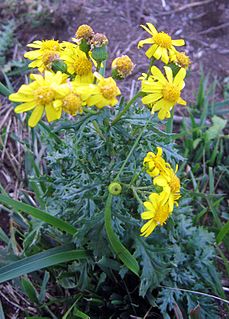
Senecio squalidus, known as Oxford ragwort, is a flowering plant in the daisy family Asteraceae. It is a yellow-flowered herbaceous plant, native to mountainous, rocky or volcanic areas, that has managed to find other homes on man-made and natural piles of rocks, war-ruined neighborhoods and even on stone walls. These habitats resemble its well drained natural rocky homeland. The plants have spread via the wind, rail and the activities of botanists. The travels of this short-lived perennial, biennial, or winter annual make it a good subject for studies of the evolution and ecology of flowering plants.
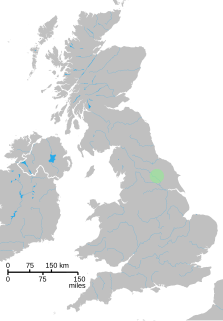
Senecio eboracensis, the York groundsel or York radiate groundsel, is a flowering plant in the daisy family Asteraceae. It is a self-pollinating hybrid species of ragwort and one of only six new plant species to be discovered in either the United Kingdom or North America in the last 100 years. It was discovered in 1979 in York, England growing next to a car park and formally described in 2003. Like many of the Senecio genus it can be found growing in urban habitats, such as disturbed earth and pavement cracks and this particular species only in York and between a railway and a car park.

Brachyglottis is a genus of flowering plants in the family Asteraceae. The genus was erected on November 29, 1775, by Johann Reinhold Forster and Georg Forster. The name was derived from the Greek brachus ("short") and glottis a reference to the size of the ray florets.

Erechtites is a genus of flowering plants in the daisy family known commonly as fireweeds or burnweeds. They are native to the Americas and Australia, but some species are widely distributed weeds.

Senecio flaccidus, formerly recorded as Senecio douglasii, member of the daisy family and genus Senecio also known as threadleaf ragwort, is a native of the southwestern Great Plains of North America.

Tephroseris palustris, also known by its common names swamp ragwort, northern swamp groundsel, marsh fleabane, marsh fleawort, clustered marsh ragwort and mastodon flower, a herbaceous species of the family Asteraceae. It can be seen most easily when its bright yellow umbel flowers appear from May to early July standing 3 to 4 feet along marshes, stream banks and slough areas where it likes to grow.
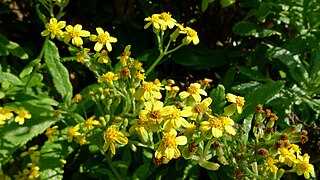
Senecio madagascariensis, also known as Madagascar ragwort, is a species of the genus Senecio and family Asteraceae that is native to Southern Africa. Other common names include Madagascar groundsel and fireweed. It has been included on the noxious weeds list for Hawaii and the reject list for Australia. S.madagascariensis is the diploid cytotype of S.inaequidens.

Senecio triangularis, known as arrowleaf ragwort, arrowleaf groundsel and arrowleaf butterweed, is a species of the genus Senecio and family Asteraceae.

Asplenium trichomanes, the maidenhair spleenwort, is a small fern in the spleenwort genus Asplenium. It is a widespread and common species, occurring almost worldwide in a variety of rocky habitats. It is a variable fern with several subspecies.

Solidago altissima, the tall goldenrod or late goldenrod, is a North American species of goldenrod in the family Asteraceae which is widespread across much of Canada, the United States, and northern Mexico. It is common in much of its range and fairly tolerant of landscapes which have been disturbed by humans. It has become naturalized in many parts of the world.
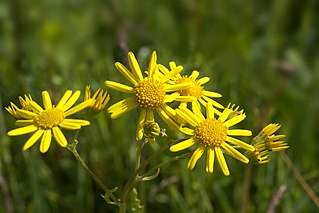
Jacobaea aquatica or Senecio aquaticus, the water ragwort or marsh ragwort, is a plant of the family Asteraceae. It is a perennial or biennial plant: young plants form a rosette near the ground, eventually producing a taller flowering shoot with many bright yellow flower heads, each with prominent ray florets. It grows in damp, grazed grassland, especially where there has been some disturbance.

Senecio quadridentatus is native to Australia and New Zealand. In New Zealand it is known by its Māori name pahokoraka or pekapeka. Senecio quadridentatus is an annual or perennial herbaceous flowering plant in the family Asteraceae. It is also known as Erechtites quadridentata Labill by the synonyms.





















